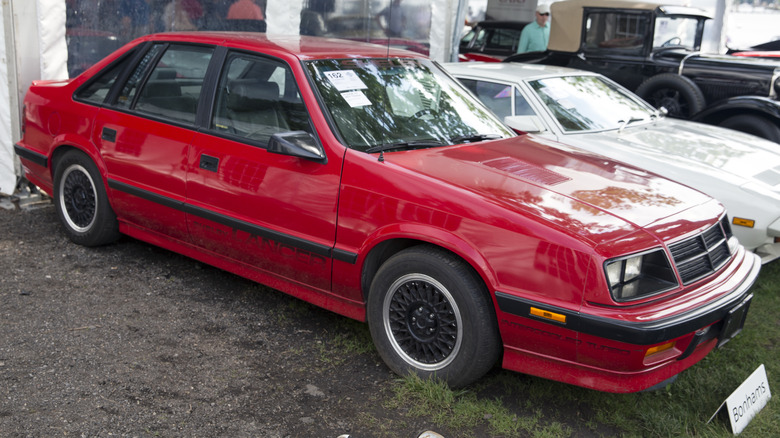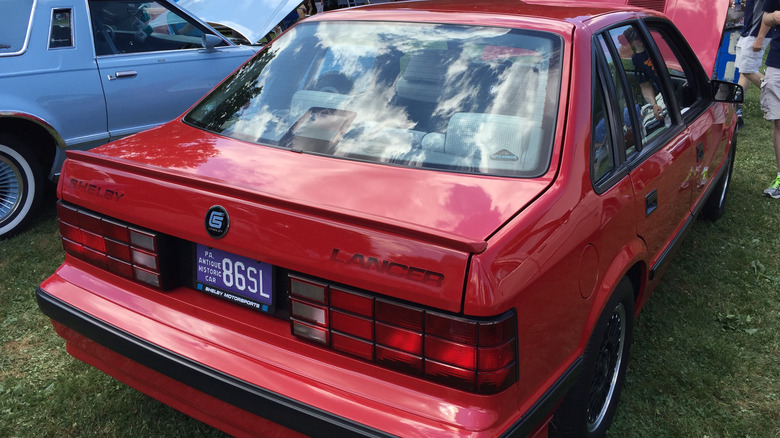4 Reasons The Dodge Lancer Shelby Is Cooler Than You Remember
The 1980s were a fascinating era for automobiles, with the latest developments in engine power, body designs, and internal amenities rolling out to the public and into our hearts. It wasn't just about building cars anymore, but building better cars; ones that could go faster, offer new and interesting features, and comfortably haul the entire family on a cross-country road trip. There's a reason that cars featured so prominently in music videos in that era, because that was a time when blasting down the highway with the top down was peak cool.
One brand that was really putting its A-game in at the time was Dodge, newly reborn as a performance-oriented spin-off from Chrysler. Creations like the Omni GLH-S were making waves in the sport sedan scene, not to mention giving major competitors like Ferrari a run for their money. During this highly competitive period, Dodge released a handful of different models, tinkering slightly with different body types and engines in an effort to find that customer-pleasing sweet spot.
One such experiment was the Dodge Lancer Shelby: A seemingly simple sport sedan on the surface, but if you look closer, you'd see a vehicle with an incredible pedigree, surprising performance, and the gold standard of '80s-era comfort.
[Featured image by Mr.choppers via Wikimedia Commons | Cropped and scaled | CC BY-SA 3.0]
The original car was created by famous designer Carroll Shelby before being mass-produced
Before the Dodge Lancer Shelby had its full moniker, the original version manufactured in 1987 was just the Lancer Shelby. This is because the vehicle was first built on the premises of Shelby Automobiles, a prominent third-party vehicle manufacturing plant under the direct supervision of legendary car designer and racer Carroll Shelby.
From the start of his racing career in 1952, to his passing in 2012, Shelby was a bona-fide car fanatic. The car designer expressed his love for the automotive ways with the creation of classic collaboration cars like the Ford Mustang and standalone vehicles like the Cobra race car, the Shelby Raptor, and the Shelby F-150. Even after his passing, his legacy endures, both in the form of his automotive brand — Shelby American Inc. — and the Carroll Shelby Foundation, which provides charitable aid to pediatric hospitals to support children against severe diseases.
The original Lancer Shelby, manufactured and sold by Shelby Automobiles in 1987, featured a series of refinements based on Shelby's own preferences. The ultimate goal was to create a car that would be comfortable to sit and drive around in while also packing a competitive level of performance. Following this original release, Chrysler employee Lee Iacocca, who was also a close friend of Shelby's, arranged the purchase of the vehicle's design — rebranding it as the Dodge Lancer Shelby, while making a handful of minor adjustments to make it a bit more mass-production-friendly.
The Lancer Shelby could go 0-60 in about seven seconds
Considering Carroll Shelby got his professional start in the automotive scene as a race car driver, it shouldn't come as a surprise that any vehicle that sprung forth from his mind would have performance as top-of-the-list bullet point. The Dodge Lancer Shelby may have looked like an ordinary sport sedan on the outside, especially with its convenient hatchback in the rear. However, under the hood was a dreamland of performance components, whether you were using the stock 5-speed transmission or cruising automatic.
The Dodge Lancer Shelby featured an intercooled 2.2L Turbo II engine with a fearsome 2,213cc displacement and 174 horsepower. Put the pedal down, and this beast could take off from 0-60 miles per hour in about seven seconds, with a rated top speed of around 137 miles per hour. The Lancer Shelby was an absolute rocket compared to some of its contemporaries of the era, though some of its performance-oriented features like an extra 25 lb-ft of turbo lag and torque steering were a bit too intimidating for casual drivers. If you were looking for a car that could really handle the rigors of the road, though, the Lancer Shelby could tackle corners like an absolute champ.
[Image by Mr.choppers via Wikimedia Commons | Cropped and scaled | CC BY-SA 3.0]
It had many cool interior features like a ten-speaker Pioneer CD system
Of course, the Dodge Lancer Shelby wasn't a race car, but rather a sporty hatchback, something you could drive around in with your family on the weekends. Race cars are about the furthest thing from modern comfort, which is why the Lancer Shelby featured a variety of nifty amenities and luxuries in its interior design.
One of the coolest features in the dashboard was a 120-watt DEX 77 AM/FM/CD stereo system from Pioneer, complete with a nine-band graphic equalizer. Pioneer had released the original car-mounted CD player, the CDX-1, in 1984, and it swiftly became the hottest ticket for any self-respecting vehicle. To take full advantage of this lovely feature, the Lancer Shelby was equipped with a 10-speaker setup to really circulate your favorite driving tunes throughout the cabin.
The sporty, ergonomic seats featured built-in lumbar support and headrests to make your journeys pleasant and comfortable. The material they were wrapped with depended on your model; five-speed Lancer Shelby models had premium cloth seats, while the automatic model came with leather seats. Other standout amenities include a full air conditioning system, an overhead console with a compass and outside temperature sensor, power windows and door locks, and even remote-controlled outer mirrors.
[Image by CZmarlin — Christopher Ziemnowicz via Wikimedia Commons | Cropped and scaled | CC BY-SA 4.0]
Less than 1,300 examples are believed to have been made, making it a collector's item
Including the original Shelby-only production of the Lancer in 1987, Dodge only sold the Lancer Shelby for a few years from 1988 to 1989. Around 800 of the original Shelby production models are believed to have been manufactured, while the Dodge-made run was substantially smaller, with a hair's shy of 500 estimated to have been created.
The aforementioned performance-oriented components may have been a bit too intense for day-to-day drivers who just wanted something simple and comfortable, prompting criticism for an engine exceeding 150 horsepower. Some reports also claim problems with the vehicle's shocks and turbos, as well as occasional electrical system concerns. The Lancer Shelby didn't do too hot as an import car either, as the interior was too different from what European drivers were used to.
Still, despite the short run and relative unpopularity, the Lancer Shelby has its place in automotive history, thanks in large part to Carroll Shelby's pedigree, so it's managed to pick up some collector's value. Based on data from Bring a Trailer and Cars & Bids, an original '87 Lancer Shelby in primo condition can fetch around $10,000 at auction, while an '88 or '89 model in similarly good condition has gone for as high as $12,000.
[Image by CZmarlin — Christopher Ziemnowicz via Wikimedia Commons | Cropped and scaled | CC BY-SA 4.0]




